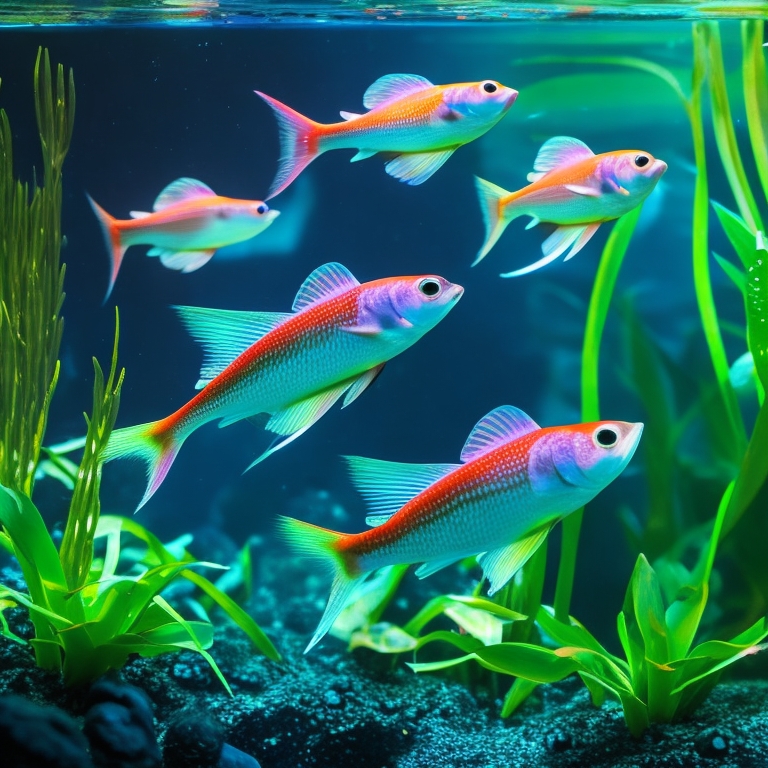If you’re a fish owner, you need to be aware of the dangers of Neon Tetra Disease. This article will provide you with a comprehensive understanding of this affliction.
You’ll learn about the causes, symptoms, diagnosis, and treatment options available to combat this disease. Additionally, you’ll discover effective prevention and management strategies that will help safeguard the health of your beloved neon tetras.
Stay informed and ensure the well-being of your aquatic companions.
Causes of Neon Tetra Disease
You should be aware of the various causes of Neon Tetra Disease. This disease is caused by a parasitic organism called Pleistophora hyphessobryconis.
The transmission methods of this disease are primarily through contaminated water and infected fish. When an infected fish dies in the aquarium, the parasite can be released into the water, infecting other fish. Additionally, the parasite can be introduced to the aquarium through infected fish that are bought and added to the tank.
Once the parasite enters the fish’s body, it starts to multiply and spread, causing damage to various organs and tissues. This disease has a significant impact on the aquarium ecosystem, as it can lead to a decrease in fish population and disrupt the balance of the tank.
It’s crucial to prevent the introduction of infected fish and maintain proper water hygiene to reduce the risk of Neon Tetra Disease.
Symptoms of Neon Tetra Disease
If your fish are exhibiting symptoms such as a loss of appetite, faded coloration, or abnormal swimming patterns, it could be a sign of neon tetra disease. This disease, caused by the parasite Pleistophora hyphessobryconis, is common among neon tetras in aquariums.
To treat neon tetra disease, it’s essential to isolate the infected fish immediately. Medications containing antibiotics like metronidazole or furazolidone can be effective in treating the disease.
However, prevention is always better than cure. To prevent neon tetra disease, ensure that you maintain good water quality in the aquarium by regularly testing and cleaning it. Quarantine new fish before introducing them to the tank to prevent the spread of any potential diseases. Additionally, feeding a balanced diet and providing proper care can help boost the immune system of your neon tetras, making them less susceptible to diseases.
Diagnosis and Testing for Neon Tetra Disease
To diagnose neon tetra disease, observe the behavior and appearance of your fish for any signs of illness. Look for the following indicators:
- Behavioral changes:
- Lethargy or decreased activity levels
- Loss of appetite or refusal to eat
- Isolation from other fish in the tank
- Physical symptoms:
- Faded or dull coloration
- Fin deterioration or fraying
- Abdominal swelling or bloating
- Lesions or sores on the body
Once you suspect neon tetra disease, it’s crucial to confirm the diagnosis through testing methods such as microscopic examination of fish tissues or PCR (Polymerase Chain Reaction) analysis. These tests can detect the presence of the disease-causing parasite, Pleistophora hyphessobryconis.
It’s important to note that treatment effectiveness may vary, as neon tetra disease can be challenging to eradicate completely. Additionally, transmission routes include contaminated water, infected fish, or contaminated equipment.
Regular monitoring and preventive measures are essential to maintain the health of your neon tetras.
Treatment Options for Neon Tetra Disease
The available treatment options for neon tetra disease include medication, water parameter adjustments, and quarantine measures. Medication options for neon tetra disease include antibiotics such as erythromycin and tetracycline, which can be administered through the fish’s food or added to the water. These medications help to combat the bacterial infection that causes the disease. It is important to follow the dosage instructions provided by the manufacturer and to continue the treatment for the recommended duration. In addition to medication, adjusting the water parameters is crucial for the recovery of affected fish. Maintaining clean water with appropriate temperature, pH, and ammonia levels can help boost the immune system and prevent further stress on the fish. Quarantine measures should also be implemented to prevent the spread of the disease to other fish in the aquarium. This involves isolating the infected fish in a separate tank and closely monitoring their progress. Natural remedies for neon tetra disease include the use of herbal extracts like tea tree oil or Indian almond leaves, which possess antimicrobial properties. However, it is important to note that these natural remedies may not be as effective as medication and should be used as a complementary treatment alongside proper medication and water parameter adjustments.
| Medication Options | Natural Remedies |
|---|---|
| Erythromycin | Tea Tree Oil |
| Tetracycline | Indian Almond Leaves |
Prevention and Management of Neon Tetra Disease
Maintaining proper hygiene and regularly monitoring the health of your fish are essential for preventing and managing this common aquarium ailment.
Neon tetra disease, caused by the parasite Pleistophora hyphessobryconis, can be devastating to your fish population if left untreated.
To prevent the spread of the disease, it’s important to quarantine new fish before introducing them to your main aquarium. This allows you to observe any signs of infection and prevent the parasite from spreading to healthy fish.
Additionally, effective medications such as formalin and malachite green can be used to manage the disease. These medications work by targeting the parasite and preventing its reproduction, ultimately reducing the impact of neon tetra disease.
Regularly monitoring water parameters and maintaining a clean environment will further support the prevention and management of this disease.
Conclusion
In conclusion, Neon Tetra Disease is a highly contagious condition caused by the parasite Pleistophora hyphessobryconis. It affects neon tetras and other small tropical fish, leading to severe health issues and even death.
Common symptoms include loss of appetite, weight loss, and abnormal swimming behavior. Diagnosis is typically done through microscopic examination of infected tissues.
Although there’s no known cure for Neon Tetra Disease, prevention measures such as proper tank hygiene and quarantine procedures are crucial to managing and minimizing the spread of the disease.

